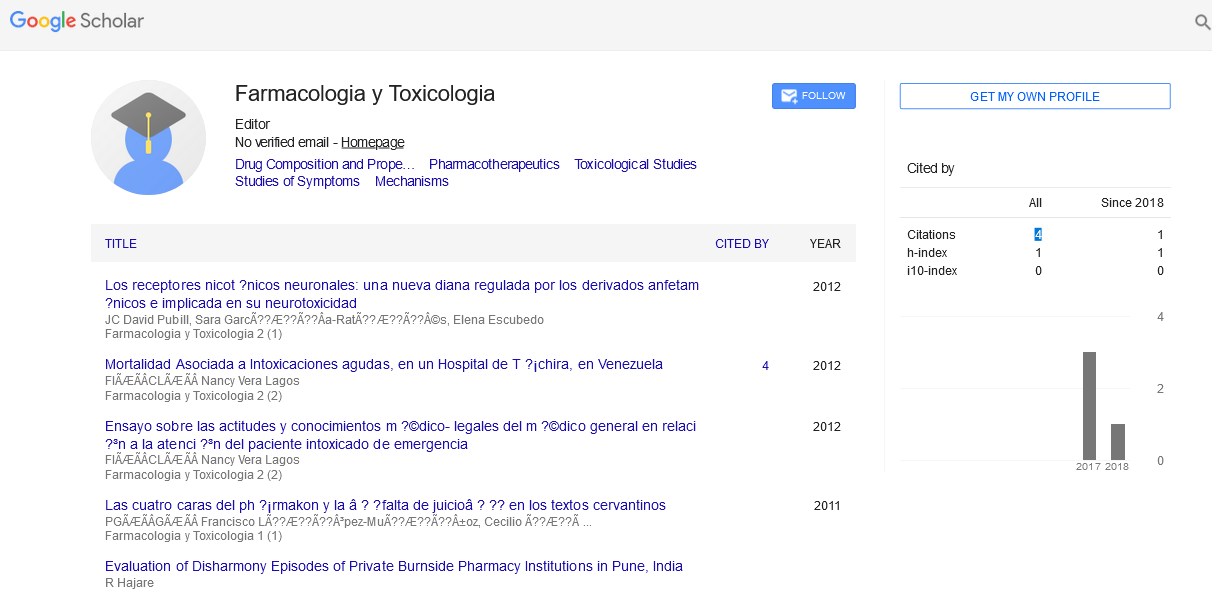Perspective - (2024) Volume 14, Issue 4
In Vitro Assays in Pharmacology: A Comprehensive Overview
Eliana Abdelhay*
Department of Pharmacology, University of Harilde, Bielefeld, Germany
*Correspondence:
Eliana Abdelhay, Department of Pharmacology, University of Harilde, Bielefeld,
Germany,
Email:
Received: 02-Jul-2024, Manuscript No. IPFT-24-14972;
Editor assigned: 05-Jul-2024, Pre QC No. IPFT-24-14972 (PQ);
Reviewed: 19-Jul-2024, QC No. IPFT-24-14972;
Revised: 01-Aug-2024, Manuscript No. IPFT-24-14972 (R);
Published:
29-Aug-2024
Introduction
In pharmacology, the study of drug effects and interactions, in
vitro assays play a pivotal role in understanding how substances
interact with biological systems outside of living organisms.
These assays are essential for evaluating drug efficacy, toxicity
and mechanisms of action before advancing to more complex
and costly in vivo studies. This article provides a comprehensive
overview of in vitro assays, their significance in pharmacology,
types, applications and future directions.
Description
In vitro assays
In vitro assays refer to experiments conducted outside of a
living organism, typically within a controlled environment such
as a test tube or a petri dish. These assays allow researchers to
observe and measure biological processes and responses to
drugs under controlled conditions. By isolating specific
components of biological systems, researchers can investigate
how drugs interact with cells, tissues or biochemical pathways.
Signi icance in pharmacology
The primary goal of in vitro assays in pharmacology is to
provide early insights into the potential effects of drugs,
including their potency, mechanisms of action and potential
toxicity. By identifying promising compounds and understanding
their biological activity at a cellular level, researchers can
prioritize which candidates should progress to animal studies
and eventually clinical trials. This early screening process helps
to streamline drug discovery and development, reducing the
time and costs associated with bringing new therapies to
market.
Types of in vitro assays
Cell viability assays: These assays assess the effects of drugs
on cell survival and proliferation. Common techniques include
the MTT assay, which measures mitochondrial activity and the
LDH release assay, which detects cell membrane damage. These
assays are pivotal in determining the cytotoxicity and potential
therapeutic benefits of drug candidates.
Receptor binding assays: These assays determine how drugs
interact with specific receptors on cell surfaces. Radioligand binding assays and enzyme-linked receptor assays are examples
used to study receptor-drug interactions. Techniques such as
radioligand binding assays and Enzyme-Linked Immunosorbent
Assays (ELISA) are used to quantify the affinity and specificity of
drugs for receptors, enzymes or other biomolecules.
Understanding these interactions aids in optimizing drug potency
and selectivity.
Enzyme activity assays: Researchers use these assays to
measure the impact of drugs on enzyme function. They are
crucial for studying metabolic pathways and enzyme inhibition,
which can inform drug metabolism and potential side effects.
Gene expression assays: Techniques such as RT-PCR and
microarrays allow researchers to examine changes in gene
expression caused by drug exposure. This helps in understanding
how drugs influence cellular processes at the molecular level.
Toxicity screening assays: These assays assess the potential
adverse effects of drugs on cells or tissues. They are essential for
predicting the safety profile of drug candidates and identifying
compounds that may cause harm in vivo.
Applications in drug discovery and development
In vitro assays play a vital role throughout the drug discovery
and development process:
Target identi ication and validation: Assays help identify
molecular targets involved in disease pathways, validating them
as potential targets for drug intervention.
Hit identification: Screening libraries of compounds against
specific targets to identify potential drug candidates with
desired biological activity.
Lead optimization: Evaluating and modifying lead compounds
to enhance potency, selectivity and pharmacokinetic properties.
Safety assessment: Assessing the safety profile of drug
candidates to predict potential adverse effects and inform
regulatory decisions.
Advantages and challenges
Cost and time efficiency: In vitro assays are generally quicker
and more cost-effective than in vivo studies.
Ethical considerations: Reducing reliance on animal testing
aligns with ethical concerns and regulatory requirements.
Controlled conditions: Allows precise control over
experimental variables, enhancing reproducibility and reliability
of results.
Biological relevance: Results from in vitro assays may not
always translate accurately to in vivo settings due to differences
in biological complexity.
Model limitations: Simplified models may not fully capture
the dynamic interactions and responses observed in living
organisms.
Validation: Ensuring assays accurately reflect physiological
conditions and predict clinical outcomes remains a challenge.
Future directions
The future of in vitro assays in pharmacology is poised for
advancements in several areas:
Organ-on-a-chip technology: Mimicking organ-level functions
and interactions in microfluidic devices to better predict drug
responses.
3D cell culture models: Enhancing the biological relevance of in vitro assays by using three-dimensional cultures that better
mimic tissue architecture and function.
High-throughput screening: Automating and miniaturizing
assays to screen large compound libraries efficiently,
accelerating drug discovery.
Conclusion
In vitro assays are indispensable tools in pharmacology,
providing critical insights into drug effects and mechanisms at
the cellular and molecular levels. While they have limitations,
advancements in technology and methodologies continue to
enhance their relevance and predictive power in drug discovery
and development. As researchers strive to innovate and refine
these techniques, the future holds promise for more effective
and safer therapies reaching clinical application. The integration
of robust in vitro assays with complementary in vivo studies
remains essential for advancing pharmacological research and
improving patient outcomes in the field of medicine.
Citation: Abdelhay E (2024) In Vitro Assays in Pharmacology: A Comprehensive Overview. Farmacologia Toxicologia, Vol.14 No.4: 035





